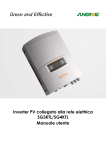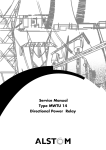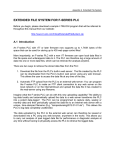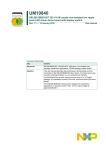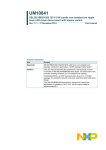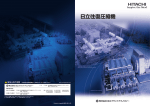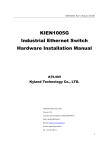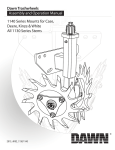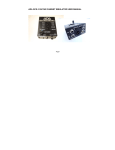Download A.O. Smith NW 37-670 Instruction Manual
Transcript
DURA-POWER MODELS NW 37- 670 COMMERCIAL ELECTRIC WATER BOILERS • Installation • Operation • Service • Maintenance • Limited Warranty STANDARD CAUTION TEXT PRINTED OR OUTLINED IN RED CONTINS INFORMATION RELATIVE TO YOUR SAFETY. PLEASE READ THOROUGHLY BEFORE INSTALLING AND USING THE APPLIANCE. FLOOD WARNING IF THE BOILER SHOULD BECOME IMMERSED IN WATER AT ANY TIME, THE BOILER SHOULD BE EXAMINED BY A COMPETENT SERVICE PERSON BEFORE IT IS RETURNED TO SERVICE. A DIVISION OF A.O. SMITH CORPORATION RENTON, WASHINGTON www.hotwater.com PLACE THESE INSTRUCTIONS ADJACENT TO THE BOILER AND NOTIFY OWNER TO KEEP FOR FUTURE REFERENCE.BE SURE THAT THE WARRANTY INFORMATION HAS BEEN FILLED IN ON COMPLETION OF INSTALLATION. PRINTED IN U.S.A. 0004G 0900 PART NO. 60047-002 REV.2 1 DIMENSIONAL DATA SIZES AND DATA 45KW THRU 720KW Model Number Inlet* & Prefix Gal.Cap. Std.KWInput D E F G** H J K S T U Outlet* NW 37 45K 32 30 12 42 12 1/2 20 4 42 3 NW 37 60K 32 30 12 42 12 1/2 20 4 42 3 NW 37 75K 32 30 12 42 12 1/2 20 4 42 2 NW 37 90K 32 30 12 42 12 1/2 20 4 42 3 NW 37 105K 32 30 12 42 12 1/2 20 4 42 3 NW 37 120K 32 30 12 42 12 1/2 20 4 42 3 NW 37 150K 32 30 12 42 12 1/2 20 4 42 3 NW 37 180K 32 30 12 42 12 1/2 20 4 42 3 NW 60 210K 32 30 12 57 12 1/2 20 4 57 3 NW 60 240K 32 30 12 57 12 1/2 20 4 57 3 NW 60 270K 32 30 12 57 12 1/2 20 4 57 3 NW 60 300K 32 30 12 57 12 1/2 20 4 57 3 NW 96 330K 40 38 16 691/2 17 1 1/2 17 24 5 78 4 NW 96 390K 40 38 16 69 1/2 17 1 1/2 17 24 5 78 4 NW 96 420K 40 38 16 69 1/2 17 1 1/2 17 24 5 78 4 NW 96 450K 40 38 16 69 1/2 17 1 1/2 17 24 5 78 4 NW 96 480K 40 38 16 69 1/2 17 1 1/2 17 24 5 78 4 NW 150 540K 54 44 19 69 1/2 20 2 20 27 5 1/2 69 1/2 5 NW 150 600K 54 44 19 69 1/2 20 2 20 27 5 1/2 69 1/2 5 NW 150 660K 54 44 19 69 1/2 20 2 20 27 5 1/2 69 1/2 5 NW 150 720K 54 44 19 69 1/2 20 2 20 27 5 1/2 691/2 5 * All fittings under 4” will be threaded type. All fittings 4” and larger will be flanged. 3” fittings extend 4” beyond jacket. ** Where overall height is a problem a larger diameter vessel with a reduced height may be furnished. Lifting lugs and channel skid base on 96 gallon and larger units. 2 Boiler Drain 1 1 1 1 1 1 1 1 1 1 1 1 1 1/4 1 1/4 1 1/4 1 1/4 1 1/4 1 1/2 1 1/2 1 1/2 1 1/2 SIZES AND DATA 780KW THRU 3300KW Model Number Prefix Gal.Cap. Std.KWInput D E F G** H J K S T NW 220 780K 60 50 25 71 21 2 25 1/2 30 5 1/2 NW 220 840K 60 50 25 71 21 2 25 1/2 30 5 1/2 NW 220 900K 60 50 25 71 21 2 25 1/2 30 5 1/2 NW 220 960K 60 50 25 71 21 2 25 1/2 30 5 1/2 NW 220 1020K 60 50 25 71 21 2 25 1/2 30 5 1/2 NW 220 1080K 60 50 25 71 21 2 25 1/2 30 5 1/2 NW 220 1140K 60 50 25 71 21 2 25 1/2 30 5 1/2 NW 334 1200K 60 50 25 99 25 2 25 1/2 30 7 1/4 NW 334 1260K 60 50 25 99 25 2 25 1/2 30 7 1/4 NW 334 1380K 60 50 25 99 25 2 25 1/2 30 7 1/4 NW 334 1500K 60 50 25 99 25 2 25 1/2 30 7 1/4 NW 334 1620K 60 50 25 99 25 2 25 1/2 30 7 1/4 NW 334 1740K 60 50 25 99 25 2 25 1/2 30 7 1/4 NW 400 1800K 66 56 28 90 1/2 25 1/2 2 1/2 30 33 7 3/4 NW 400 1860K 66 56 28 90 1/2 25 1/2 2 1/2 30 33 7 3/4 NW 400 1980K 66 56 28 90 1/2 25 1/2 2 1/2 30 33 7 3/4 NW 400 2100K 66 56 28 90 1/2 25 1/2 2 1/2 30 33 7 3/4 NW 500 2200K 72 62 31 90 1/2 26 1/2 2 1/2 34 36 7 3/4 NW 500 2340K 72 62 31 90 1/2 26 1/2 2 1/2 34 36 7 3/4 NW 500 2460K 72 62 31 90 1/2 26 1/2 2 1/2 34 36 7 3/4 NW 500 2580K 72 62 31 90 1/2 26 1/2 2 1/2 34 36 7 3/4 NW 670 2700K 78 68 34 96 1/2 30 1/2 2 1/2 38 39 7 3/4 NW 670 2820K 78 68 34 96 1/2 30 1/2 2 1/2 38 39 7 3/4 NW 670 2940K 78 68 34 96 1/2 30 1/2 2 1/2 38 39 7 3/4 NW 670 3060K 78 68 34 96 1/2 30 1/2 2 1/2 38 39 7 3/4 NW 670 3180K 78 68 34 96 1/2 30 1/2 2 1/2 38 39 7 3/4 NW 670 3300K 78 68 34 96 1/2 30 1/2 2 1/2 38 39 7 3/4 NOTE: For boilers 3400KW to 6000KW, consult factory. * All fittings under 4” will be threaded type. All fittings 4” and larger will be flanged. ** Where overall height is a problem a larger diameter vessel with a reduced height may be furnished. 3 Inlet* & Outlet* 5 5 5 5 5 5 5 6 6 6 6 6 6 8 8 8 8 8 8 8 8 8 8 8 8 8 8 Boiler Drain 1 1/2 1 1/2 1 1/2 1 1/2 1 1/2 1 1/2 1 1/2 2 2 2 2 2 2 2 2 2 2 2 2 2 2 2 2 2 2 2 2 ELECTRICAL/RECOVERY DATA WATER BOILER SPECIFICATIONS BTU Output 153,585 204,720 255,975 307,170 358,365 409,560 511,950 614,340 716,730 819,120 921,510 1,023,900 1,126,290 1,228,680 1,331,070 1,433,460 1,535,850 1,638,240 1,843,020 2,047,800 2,252,580 2,457,360 2,662,140 2,866,920 3,071,700 3,276,480 3,481,260 3,636,040 3,890,820 4,095,600 4,300,380 4,709,940 5,119,500 5,529,060 5,938,630 6,143,400 6,348,180 6,757,740 7,167,300 7,576,860 7,986,420 8,395,980 8,805,540 9,315,100 9,624,660 10,034,220 Gal./Hr. 100°F Rise 180 240 300 369 430 492 615 738 861 984 1107 1230 1353 1476 1599 1722 1845 1968 2214 2460 2706 2952 3198 3444 3690 3936 4182 4428 4674 4920 5166 5658 6150 6642 7134 7380 7626 8118 8610 9102 9594 10080 10578 11070 11562 12054 Number of Elements 3 4 5 6 7 8 10 12 14 16 18 20 22 24 26 28 30 32 36 40 44 48 52 56 60 64 68 72 76 80 84 92 100 108 116 120 124 132 140 148 156 164 172 180 188 196 NOTE: For boilers 3000KW to 6000KW consult factory. MODEL AND RATING PLATE 4 Number of Steps 1 1 1 3 4 4 5 5 5 5 5 5 6 6 7 7 8 8 9 10 10 8 9 10 10 10 10 10 10 10 10 10 10 15 15 15 15 15 15 15 20 20 20 20 20 20 Standard Number and KW of Steps 1@45 1@60 1@75 3@30 3@30+1@15 4@30 5@30 4@30+1@60 3@30+2@60 2@30+3@60 1@30+4@60 5@60 5@60+1@30 6@60 6@60+1@30 7@60 7@60+1@30 8@60 9@60 10@60 8@60+2@90 8@90 8@90+1@60 9@90+1@30 10@90 8@90+2@120 6@90+4@120 4@90+6@120 2@90+8@120 10@120 8@120+2@150 4@120+6@150 10@150 6@90+9@120 2@90+13@120 15@120 13@120+2@150 9@120+6@150 5@120+10@150 1@120+14@150 18@120+2@90 18@120+2@150 14@120+6@150 10@120+10@150 6@120+14@150 2@120+18@150 208v 128 171 213 250 292 334 417 500 584 668 751 834 917 1001 1084 1168 1251 1334 1501 1668 Amperage 3 Phase 240V 480V 575V 108 55 45 144 73 60 180 90 75 217 108 90 253 126 105 289 144 121 361 180 151 433 216 181 505 252 211 577 288 241 650 324 271 722 360 301 794 396 331 866 432 362 938 468 392 1010 504 422 1083 540 452 1155 576 487 1299 648 542 1443 720 602 792 663 864 723 936 783 1008 843 1080 904 1152 964 1224 1024 1296 1084 1368 1145 1440 1205 1512 1265 1656 1386 1800 1506 1944 1627 2068 1747 2160 1807 2232 1868 2376 1988 2520 2109 2664 2229 2808 2350 2952 2470 3096 2590 3240 2711 3384 2832 3528 2952 Not Recommended Std. KW Input 45K 60K 75K 90K 105K 120K 150K 180K 210K 240K 270K 300K 330K 360K 390K 420K 450K 480K 540K 600K 660K 720K 780K 840K 900K 960K 1020K 1080K 1140k 1200K 1260K 1380K 1500K 1620K 1740K 1800K 1860K 1980K 2100K 2200K 2340K 2460K 2580K 2700K 2820K 2940K Not Recommended Model Number Gal. Prefix Cap. NW 37 NW 37 NW 37 NW 37 NW 37 NW 37 NW 37 NW 37 NW 60 NW 60 NW 60 NW 60 NW 96 NW 96 NW 96 NW 96 NW 96 NW 96 NW 150 NW 150 NW 150 NW 150 NW 220 MW 220 NW 220 NW 220 NW 220 NW 220 NW 220 NW 334 NW 334 NW 334 NW 334 NW 334 NW 334 NW 400 NW 400 NW 400 NW 400 NW 500 NW 500 NW 500 NW 500 NW 670 NW 670 NW 670 FOREWORD APPROVALS INSTALLATION CODE REQUIREMENTS These designs comply with requirements of Underwriters Laboratories and bear the U.L. label on the cabinet. In addition to these instructions, the equipment shall be installed in accordance with those installation regulations in force in the local area where the installation is to be made. These shall be carefully followed in all cases. Authorities having jurisdiction should be consulted before installations are made. All models are built to the standards of Section lV of the American Society of Mechanical Engineers. Boiler and Pressure Code, inspected and identified by this symbol. In absence of local codes the installation must comply with the latest edition of the National Electrical Code, NFPA 70. Copies of this document are available from the National Fire Protection Association, 1 Batterymarch Park, Quincy, MA 02269. GROUNDING The ASME plate is located on the tank above the cleanout opening. When specified, the National Board of Boiler and Pressure Vessel Inspectors listing will be furnished and identified by an NB number on the ASME plate. Grounding and electrical wiring connected to the boiler must conform to the latest edition of the National Electric Code, NFPA 70. Figure 1, below, is an illustration of a typical model NW/Commercial Electric Hot Water Boiler with the features called out. FEATURES FIGURE 1 5 IMPORTANT LOCATING THE BOILER IT IS RECOMMENDED THAT A QUALIFIED SERVICE TECHNICIAN PERFORM THE INITIAL FIRING OF THE BOILER. AT THIS TIME THE USER SHOULD NOT HESITATE TO ASK THE TECHNICIAN ANY QUESTIONS WHICH THEY MAY HAVE IN REGARD TO THE OPERATION AND MAINTENANCE OF THE BOILER. For the best installation, the boiler should be located: 1. On a level surface. • BEFORE FILLING THE SYSTEM FOR OPERATION the hot water system should be internally cleaned and flushed to remove any contaminants which may have accumulated during installation. See section of this manual titled SYSTEM CLEANING. Shim the channel type skid base as necessary if leveling is required. 2. Near a floor drain. • RELIEF VALVE An ASME rated pressure relief valve is furnished with the boiler. A fitting for the relief valve is provided in the top of the boiler. A drain line from the relief valve should terminate near a suitable drain. Do not thread, plug, or cap the end of the drain line. The boiler should be located in an area where leakage of the tank or connections will not result in damage to the area adjacent to the boiler or to lower floors of the structure. When such locations cannot be avoided, a suitable drain pan should be installed under the boiler. The pan should be at least two inches deep, have a minimum length and width of at least two inches greater than the dimensions of the boiler and should be piped to an adequate drain. The pressure setting of the relief valve should not exceed the pressure capacity of any component in the system including the boiler. • The discharge opening of the relief valve should always be piped to an open drain. 3. Suggested clearances from adjacent surfaces are found on a label attached to the control compartment door. HIGH TEMPERATURE DEVICES Automatic Device The boiler control circuit contains a high temperature cutoff switch. This device shuts off the heating elements if excessive water temperatures are reached. The high temperature cutoff has an adjustable range of 100° to 240°F and automatically resets on a drop of temperature. • UL minimum clearances: - 24” all sides - 12” top • Allow clearance for hinged control compartment doors. • Elements can be changed with 24” clearance. Manual Device A manual reset high limit will be in the control circuit in addition to the automatic device previously described. The control has an adjustable range of 110° to 290°F and must be manually reset after a drop of temperature. 4. The boiler may be installed in a confined space if adequate ventilation is provided. Reset button is located under the right side panel of the boiler. Disconnect the power before removing the panel to push the button. General ELECTRICAL Check the boiler model and rating plate information against the characteristics of the branch circuit electrical supply. Do not connect the boiler to an improper source of electricity. INSTALLATION Voltage applied to the boiler should not vary more than + 5% to -10% of the model and rating plate marking for satisfactory operation. REQUIRED ABILITY Do not energize the branch circuit for any reason before the boiler is filled with water. Doing so may cause the heating elements to burn out. Such damage is not covered under the terms of the warranty. INSTALLATION OR SERVICE OF THIS BOILER REQUIRES ABILITY EQUIVALENT TO THAT OF A LICENSED TRADESMAN IN THE FIELD INVOLVED. PLUMBING AND ELECTRICAL WORK ARE REQUIRED. The branch circuit is connected to the block through an opening provided on top of the boiler. GENERAL The boiler should be connected to a separate, grounded, branch circuit with overcurrent protection and disconnect switch. These are part of the electrical supply system not components of the boiler, as such they are obtained locally. The boiler should be grounded in accordance with national and local codes. Do not test electrical system before boiler is filled with water, follow START UP procedure in this manual. The principal components of the boiler are identified in Figure 1. The model and rating plate, see illustration on page 4, provides certain useful information required at installation. Both of these references should be used to identify the boiler and its components. Branch Circuit The branch circuit wire size should be established through reference to the National Electrical Code or other locally approved source in conjunction with boiler amperage rating. Branch circuit wiring which connects to the boiler terminal block should be temperature rated at 75°C. For convenience, portions of the wire size tables from the Code are reproduced here. It is suggested the electrician size the branch circuit at 125 percent of the boiler rating and further increase wire size as necessary to compensate for voltage drop in long runs. Branch circuit voltage drop should not exceed 3% at the boiler. Water boilers are usually placed in series with the heating system on the outlet side of the circulating pump. The boiler piping should include inlet and outlet water valves to permit maintenance and service work to be performed without disturbing the rest of the system. Detailed system installation drawings are normally provided by the equipment purchaser or system designer. 6 Calculating Amperage/Overcurrent Protection The boiler is factory wired for connection to three wire single-phase or three and four wire three-phase branch circuits. In addition, a ground conductor may be required. Portion of Table 310-16 Portion of Table 310-16 Allowable Ampacities of Insulated Copper Conductors Allowable Ampacities of Insulated Aluminum and CopperClad AluminumConductors Not more than three conductors in raceway or cable or direct burial (based on ambient temperature of 30°C, 86°F.) A diagram of the wiring is furnished with the boiler for the electrician’s use. An amperage table is on page 4 of this manual. The boiler model and rating plate provides full load amperage data. The rating of the overcurrent protection should be computed on the basis of 125 percent of the total connected load amperage. Where the standard ratings and settings do not correspond with this computation, the next higher standard rating or setting should be selected. Size AWG MCM Boiler Circuits 18 16 14 12 10 8 6 4 3 2 1 1/0 2/0 3/0 4/0 250 300 350 400 500 600 700 750 800 900 1000 1250 1500 1750 2000 The boiler’s electrical components are pictured and identified on page 5. The model and rating plate illustration on page 4 identifies the electrical characteristics. Basically, there are two electrical circuits: • The control circuit, where the temperature control directly or indirectly operates the contactor coils. • The power circuit, which is operated by the control circuit, carries the electrical load of the heating elements. The following describes the circuits and includes typical wiring diagrams. All circuits are designed for 60 or 50 Hertz alternating current. Refer to ELECTRICAL CONFIGURATION TABLE, below, and wiring diagram provided with your boiler before completing connections to electrical supply. NOTE: Wiring diagrams in this manual are typical examples. The specific wiring diagram for your boiler is the one supplied with the boiler. Control Circuit All control circuits are operated on single-phase 120V. A transformer is used in the control circuit. Temperature Rating of Conductor. See Table 310-13 in Code 75°c (167°F) TYPES RH, RHW, RUH (14-2), THW, THWN, XHHW, USE --------15 20 30 45 65 85 100 115 130 150 175 200 230 255 285 310 335 380 420 460 475 490 520 545 590 625 650 665 Not more than three conductors in raceway or cable or direct burial (based on ambient temperature of 30°C, 86°F.) Temperature Rating of Conductor. See Table Size 310-13 in Code AWG 75°C MCM (167°F) TYPES RH, RHW, RUH (12-2), THW, THWN, XHHW, USE 12 15 10 25 8 40 6 50 4 65 3 75 2 90 1 100 1/0 120 2/0 135 3/0 155 4/0 180 250 205 300 230 350 250 400 270 500 310 600 340 700 375 750 385 800 395 900 425 1000 445 1250 485 1500 520 1750 545 2000 560 These capacities relate only to conductors described in Table 310-13 in Code. For ambient temperatures over 30°C, see Correction Factors, Note 13 in Code Power Circuit Control circuit wiring is 14 Awg, THHN or THWN type, rated 600 volts, 105°C. The boiler is equipped with one of the power circuit configurations shown in the table. Seperate instructional literature is provided with the boiler for the modulating solid state step control. Power circuit wiring is type THHN, rated 600 volts, 105°C, sized as necessary. 7 Boiler Nameplate Markings Voltage Phase 1 ELECTRICAL CONFIGURATION TABLE Voltage Between Control Boiler Terminal Circuit Lugs Voltage (1 Phase) Type of Service L1 L2 N Elements Quantity Element Per Operating Contractor Voltage G 208 120 1 208 120 1 208 120 1 240 120 1 240 120 1 or 2 277 120 1or 2 480 120 208 3 Delta (With Neutral) L1 208 L1 1 L2 208 L2 L3 N G 208 120 G 240 240 3 Delta L1 L2 L3 240 240 240 G 3 Wye* L1 L2 L3 480 480 480 G 480 480 3 Delta L1 L2 L3 480 480 480 G * Neutral lug not necessary and not furnished due to three wire wye connection. This means only three wires (no neutral) brought to boiler due to method of element connection. Elements operate at 277 volts. Voltage from a conductor to ground (electrical raceway and water pipes) is not measured. No ground lug furnished. If required installer can provide locally. TYPICAL WIRING DIAGRAMS The following wiring diagrams are included in this manual to show typical arrangements of electrical components in the control and power circuits by voltage and phase charactreristics. They are to be used as a reference by the installer or servicer in performing their work. A diagram of the boiler wiring is furnished with the boiler. WIRING DIAGRAM 208V OR 240V THREE-PHASE (DELTA) WITH STEP CONTROL 8 WIRING DIAGRAM 480V THREE-PHASE (WYE) SYSTEM CLEANING OPERATION The hot water system should be internally cleaned and flushed to remove contaminants which may have accumulated during installation. System cleaning provides chemical stability necessary for component life and system performance. GENERAL Never operate the heating elements without being certain the boiler is filled with water and a pressure relief valve is installed in the relief valve opening provided. Failure to clean the system may cause: 1. Poor heating due to formation of gas. • Residual pipe dope, thread cutting oil, solder flux, dirt and other foreign materials breakdown to form gas. This is indicated by a continuing need for purging even through the system is “closed”. An electronic type low water cutoff is provided on all boilers as standard equipment. The water probe is installed near the top of the tank to monitor the presence of water. The control circuit is opened if the water level is below this point. The pilot switch on the cabinet front permits the boiler to be turned on and off without having to operate the electrical disconnect switch. Additional switches may be provided for manually operating contactor coils. 2. Pump seal leakage. • Acidic water (low pH) and contamination such as soil and sand result in premature or recurring pump seal failures. WARNING 3. Automatic air valve leakage. • Contaminants cause sticky sealing surfaces and result in leakage. Full power is present whenever the cabinet door is opened even with the pilot switch(es) turned off. Never operate the boiler with cabinet doors open or panels removed. 4. Relief valve operation. • Gas formation increases system pressure and relief valve spillage. FILLING 5. Water leaks at joints and fittings. • Corrosion and eventual failure of connections occur when system pH is low. Refer to SYSTEM CLEANING section for preparing the system prior to final filling and operation. 6. Noisy operation. • Heat transfer surfaces can be fouled with dirty, oily water. This plus gas lead to noisy water circulation. Hard Water: in areas which have hard water it may be desirable to fill the system with soft water and/or provide water treatment as recommended by a consultant familiar with local conditions. In this way harmful water scale build-up on the heating elements is minimized. 1. Close the boiler drain valve and system valves as necessary. WARNING Be sure to turn off power when working on or near the electrical system of the boiler. Never touch electrical components with wet hands or when standing in water. When replacing fuses always use the correct size for the circuit. 2. Open a vent in the highest point of the system to allow the air to escape. 3. Fully open the make-up water inlet valve. Fill the boiler and piping. 9 Tank flushing and circulating pump lubrication should be performed in accordance with the above schedule. Tank sediment removal and element lime scale removal must be performed when needed as determined by period inspections. Following are the instructions for performing recommended maintenance. 4. Close the vent as water starts to flow from the opening. Place the make-up water valve in the desired position. The boiler is now ready for START UP and TEMPERATURE REGULATION if being placed in operation for the first time. START UP FLUSHING The following checks should be made by the installer when the boiler is placed into operation for the first time: 1. Turn off the electrical disconnect switch. 2. Open the boiler drain valve. Allow water to flow to an open drain until it runs clean. Do not come in contact with the water being drained as it may be very hot. 1. Check all factory and field made water and electrical connections for tightness. • Repair water leaks and tighten electrical connections as necessary. 3. Close the drain valve when finished flushing. 2. Turn on the electrical disconnect switch and pilot switch(es) mounted on the boiler cabinet. 4. Turn on the electrical disconnect switch. 3. Observe the operation of the boiler during the first heating cycle. • Temperature control and contactor operation should be checked by allowing the boiler to come up to temperature and shutoff automatically. SEDIMENT REMOVAL TEMPERATURE REGULATION Water borne impurities consist of fine particles of soil and sand which settle out and form a layer of sediment on the bottom of the tank. In time, if not removed, the level of sediment might reach the heating elements. Always turn off the electricity at the electrical disconnect switch when making a temperature control adjustment. For convenience, sediment removal and element lime scale removal should be performed at the same time as follows: It is suggested the temperature adjustment be turned to the lowest setting which satisfies the hot water requirements of the system. • Additional instructional literature is provided with the boiler for adjusting this control. WATER AND LIME SCALE REMOVAL Water and lime scale accumulations on the heating elements is a normal condition, common to all immersion type elements. Factors which affect the amount of this formation are: Always close and lock the cabinet door after making a temperature adjustment. Turn on electricity. 1. Amount of make-up water used. As the volume of make-up water heated increases, more scale results. DRAINING 2. Water temperature. As the temperature of the water is increased, more scale is deposited on the elements. The boiler must be drained if it is to be shut down and exposed to freezing temperatures. Maintenance and service procedures may also require draining the boiler. 3. Characteristics of water supply. Regardless of water treatment, the elements should be examined regularly. 1. Turn off the electrical disconnect switch. 2. Close the make-up water valve and system valves as necessary. Water scale accumulations may cause noises to occur during operation. 3. Open a nearby outlet to vent the parts of the system being drained. It is recommended that a lower heating element be removed periodically for examination. If it is scaled, all of the elements should be removed and cleaned. If the tank bottom has an accumulation of sediment, it should be cleaned. 4. Open the boiler drain valve. 5. If the boiler is being drained for an extended shutdown, it is suggested the drain valve be left open during this period. • Follow FILLING instructions to restore boiler to service. Lime scale should be removed from the elements by dissolving the accumulation in UN•LIME® delimer. UN•LIME is a non-muriatic delimer, available through your dealer or distributor. Do not use muratic or hydrochloric acid base deliming solutions to remove lime scale from the elements. Do not pour delimer into tank. MAINTENANCE Boiler maintenance includes periodic tank flushing and cleaning, and removal of lime scale from the heating elements. Circulating pumps should be oiled. Component Tank Elements Circulating Pump(s) MAINTENANCE SCHEDULE Operation Interval Flushing Monthly Sediment As Needed Removal Lime Scale As Needed Removal Oiling All models: 1. Turn off electrical disconnect switch. Required 2. Drain the boiler following DRAINING instructions. 3. Remove the cabinet panel which covers the heating elements. UN•LIME® Delimer and element gaskets. Per pump makers instructions • Remove insulation as necessary to reach the element area. 4. Remove the bolts from each element and remove the elements from the opening. • 10 Disconnect element wiring as necessary. • Use a twisting, pulling action to remove elements scaled beyond the size of the tank opening. • Brush loose scale from elements. • Silicates, sulfates and aluminates must be removed by 3. If the water was excessively hot, and is now cold, the high temperature cutoff may have operated (manual reset equipped models). • To reset, turn off electricity and remove the back panel and push the reset button. • scraping or other mechanical means. Lime scale dissolvents will not remove these types of scale which are occasionally encountered. 4. The capacity of the boiler may have been exceeded by a large demand for heat. • Large demands require a recovery period to restore water temperature. 5. Lime scale removal: • Place limed ends of heating elements into UN•LIME delimer and allow scale to dissolve. Do not permit delimer or water to contact heating element electrical terminals. 5. Sediment or lime scale may be affecting boiler operation. Refer to MAINTENANCE for details. Water is too hot 6. Flush cleaned ends of elements with water when deliming or cleaning is completed. 1. Refer to TEMPERATURE REGULATION. 7. Remove sediment and scale from the tank bottom through the tank cleanout. • Boiler makes sounds 1. Sediment or lime scale accumulation on the elements may cause sizzling and hissing noises when the boiler is operating. • The sounds are normal , however, the tank bottom and elements should be cleaned. Refer to MAINTENANCE for details. The make-up water valve and boiler drain valve may be opened to flush during the cleanout process. 8. Clean remaining gasket material from tank and element flanges. Do not reuse original element gasket. The element gasket is Part No. 5109. 2. Some of the electrical components of the boiler make sounds which are normal. • Contactors will “click” or snap as the boiler starts and stops. 9. Replace elements as follows: • Put a new gasket on each element. • Install into tank opening. • Uniformly tighten element bolts. Torque to approximately 32 ft/lbs. • 1. Check to see if the drain valve is tightly closed. 2. If the outlet of the relief valve is leaking it may represent: • Excessive water pressure or air in the system. 11. Follow FILLING instructions to restore boiler to service. • Transformers and contactors often hum. Water leakage is suspected 10. Connect element wiring as necessary. • Repeated operation of the high temperature cutoff should be investigated by your servicer. • Check for water leaks around elements and proper operation when boiler is filled. Faulty relief valve. 3. Examine the flange area of the elements and tank cleanout for gasket leakage. • Tighten the bolts or, if necessary, follow the WATER AND LIME SCALE REMOVAL procedure to replace the gaskets. Replace insulation and cabinet panel. CHECKLIST SYSTEM WATER TEST Before calling for service, check the following points to see if the cause of trouble can be identified and corrected. Reviewing this checklist may eliminate the need of a service call and quickly restore the boiler to service. The illustration on page 5 identifies the location of most of the boiler components. System water test Review SYSTEM CLEANING section, for a description of six problems which result from loss of system chemical stability. Chemical stability is checked by: BE SURE TO TURN OFF THE ELECTRICITY WHEN CHECKING EQUIPMENT. 1. Draw off water from system. Is it dirty, discolored or odorous? Not enough or no heat 2. What is the pH of the system water? It should be neutral or slightly alkaline. 1. Be certain the electrical disconnect switch serving the boiler is in the ON position. The pilot switch(es) on the cabinet front should be on. • In some installations the boiler electrical service may be limited by the power company or boiler controls. If the boiler operates on a controlled circuit heat may be effected. 3. Does “air” purged from system vents burn? If so, the “air” is actually gas. If any of the above conditions are present, all waterways should be cleaned and the water adjusted to an alkaline condition. If you cannot identify or correct the source of malfunction: 2. Check the fuses. • The electrical disconnect switch usually contains fuses. • 1. Place the boiler electrical disconnect switch in the OFF position. 2. Close the make-up water inlet valve to the boiler. The boiler has fuses located behind the cabinet door, see page 5 for location. 3. Contact your servicer. 11 NW-37 THRU NW-670 ELECTRIC HOT WATER BOILER LIMITED WARRANTY A.O. Smith Corporation, the warrantor, extends the following LIMITED WARRANTY to the owner of this boiler. 1. THE TANK If the tank in this boiler shall prove upon examination by the warrantor to have leaked due to natural corrosion from water therein, during the FIRST year after initial installation, the warrantor will at its option, repair it or provide a replacement tank less elements and controls of equivalent size and then current model. Some government agencies are requiring energy efficient standards for boilers. In the event regulations prohibit sale of a model of equivalent size and construction, A.O. Smith will provide a model which complies with the regulations of your area, in which case the consumer will be charged the difference in price between the like replacement and the energy efficient model required. The warranty on the repair or replacement of the part, portion or tank will be limited to the unexpired term of the original warranty. 2. ALL OTHER PARTS If within ONE year after initial installation of this boiler, any part or portion shall prove upon examination by the warrantor to be defective in material or workmanship, the warrantor will repair or replace such part or portion at its option. 3. CONDITIONS AND EXPECTATIONS This warranty shall apply only when the boiler is installed in accordance with local plumbing and building codes, ordinances and regulations, the printed instructions provided with it and good industry practices. In addition, a pressure relief valve, approved by the American Society of Mechanical Engineers, must have been installed. This warranty shall apply only when the boiler is used: a. (1) at temperatures not exceeding the maximum setting of its control; (2) at water pressure not exceeding the working pressure shown on the boiler; (3) when filled with water, free to circulate at all times and with the tank free of damaging scale deposits; (4) in a noncorrosive and non-contaminated atmosphere; (5) in its original installation location; (6) in the United States, its territories or possessions, and Canada. (7) when operated free of the damaging effects of uncontrolled thermal expansion and/or water hammer. b. Any accident to the boiler, any misuse, abuse (including freezing) or alteration of it, any operation of it in a modified form will void this warranty. 4. SERVICE AND REPAIR EXPENSE Under this limited warranty the warrantor will provide only repair or a replacement tank or part thereof. The owner is responsible for all other costs. Such costs may include but are not limited to: a. Labor charges for service, removal, repair, or reinstallation of the tank or any component part; b. Shipping, delivery, handling, and administrative charges for forwarding the new tank or replacement part from the nearest distributor and returning the claimed defective tank or part to such distributor. c. All cost necessary or incidental for any materials and/or permits required for installation of the replacement tank or part. 5. LIMITATION ON IMPLIED WARRANTIES Implied warranties, including any warranty of merchantability imposed on the sale of this boiler under state law are limited to one (1) year duration for the tank or any of its parts. Some states do not allow limitations on how long an implied warranty lasts, so the above limitation may not apply to you. 6. CLAIM PROCEDURE Any claim under this warranty should be initiated with the dealer who sold the boiler, or with any other dealer handling the warrantor’s products. If this is not practicable, the owner should contact: U.S. Customers Canadian Customers A.O. Smith Corporation A.O. Smith Enterprises Ltd. 5621 W. 115th Street P.O. Box 310-768 Erie Street Alsip, IL 60803 Stratford, Ontario N5A 6T3 Telephone: 800-323-2636 Telephone: 519-271-5800 a. The warrantor will only honor replacement with identical or similar tank or parts thereof which are manufactured or distributed by the warrantor. b. Dealer replacements are made subject to in-warranty validation by warrantor. 7. DISCLAIMER NO OTHER EXPRESS WARRANTY HAS BEEN OR WILL BE MADE IN BEHALF OF THE WARRANTOR WITH RESPECT TO THE BOILER OR THE INSTALLATION, OPERATION, REPAIR OR REPLACEMENT OF THE TANK OR PARTS. THE WARRANTOR SHALL NOT BE RESPONSIBLE FOR WATER DAMAGE, LOSS OF USE OF THE UNIT, INCONVENIENCE, LOSS OR DAMAGE TO PERSONAL PROPERTY, OR OTHER CONSEQUENTIAL DAMAGE. THE WARRANTOR SHALL NOT BE LIABLE BY VIRTUE OF THIS WARRANTY OR OTHERWISE FOR DAMAGE TO ANY PERSONS OR PROPERTY, WHETHER DIRECT OR INDIRECT, AND WHETHER ARISING IN CONTRACT OR IN TORT. a. Some states do not allow the exclusion or limitation of the incidental or consequential damage, so the above limitation or exclusion may not apply to you. b. This warranty gives you specific legal rights, and you may also have other rights which vary from state to state. Fill in the following for your own reference. Keep it. Registration is not a condition of warranty. The model and ASME numbers are found on the boiler’s rating plate. Model No._______________________________________ASME No.___________________Date Installed__________________ Dealer’s Name____________________________________________________________________________________________ Dealer’s Address_____________________________________________________________Phone No.____________________ City and State_______________________________________________________________Zip___________________________ KEEP THIS WARRANTY AND MANUAL POSTED ADJACENT TO THE BOILER FOR FUTURE REFERENCE WHENEVER MAINTENANCE, ADJUSTMENT OR SERVICE IS REQUIRED. BE SURE YOUR DEALER HAS FILLED IN THIS WARRANTY. 12













